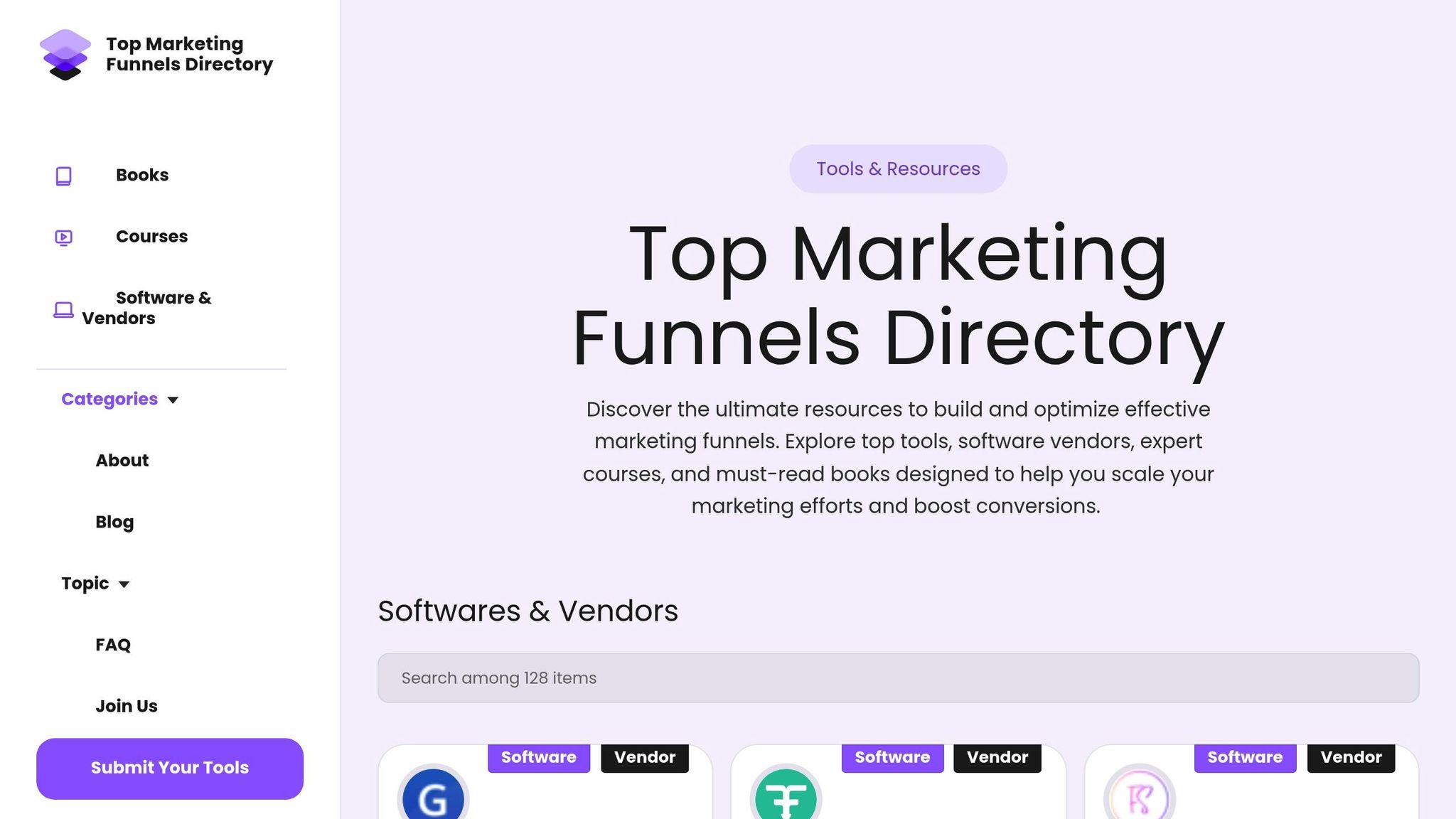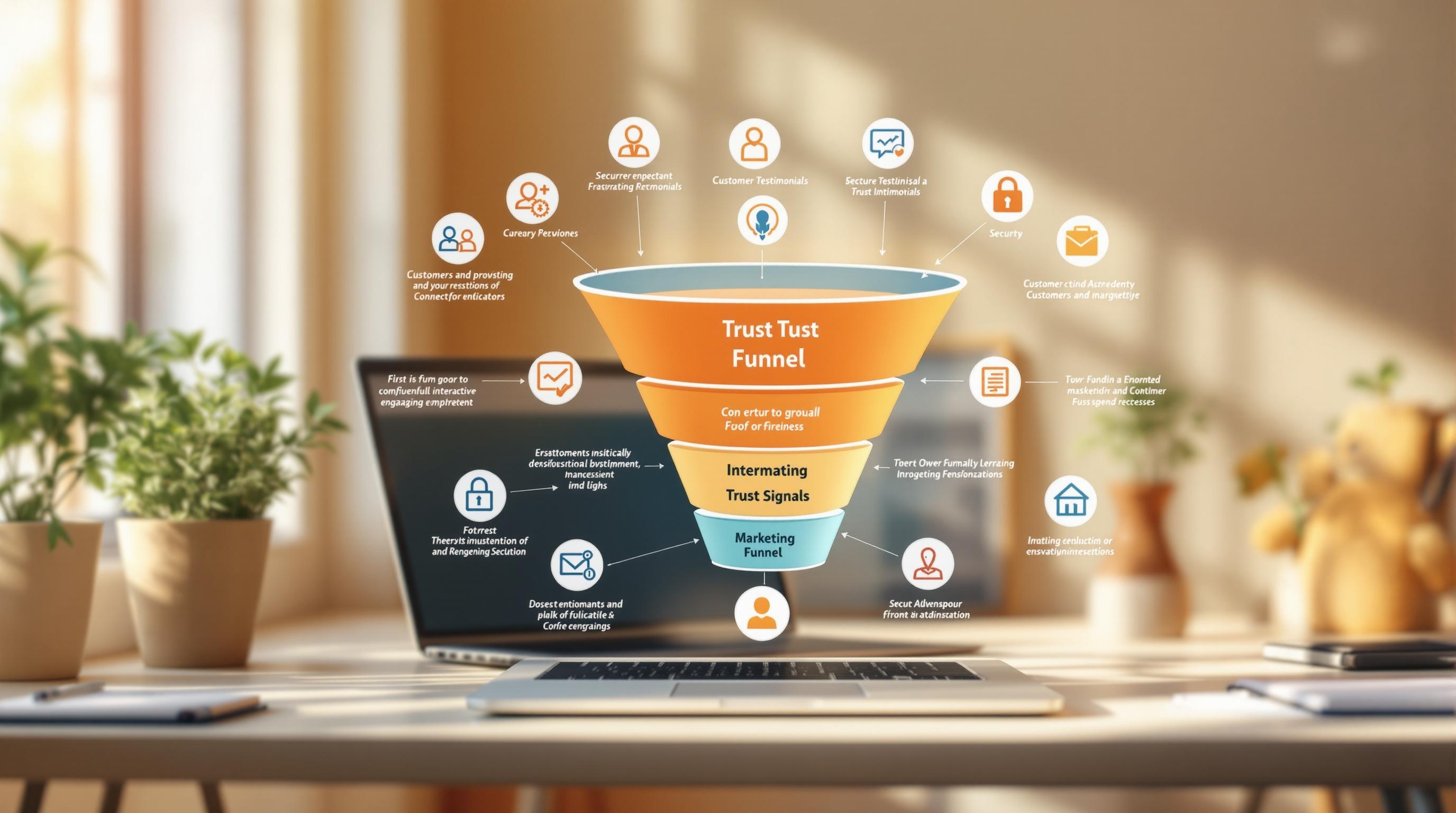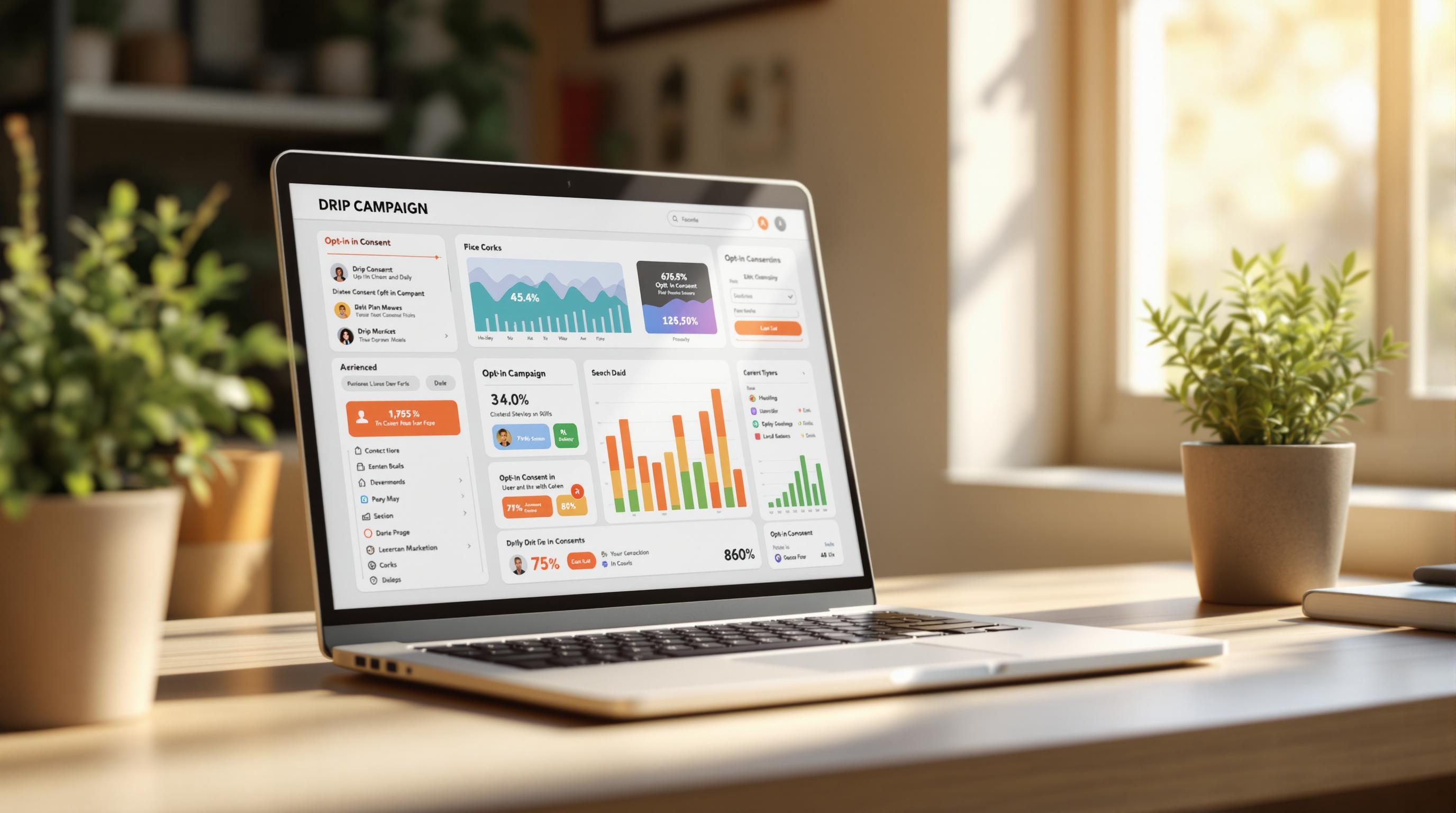Allocating your social media ad budget effectively ensures better results at every stage of your funnel: awareness, consideration, and conversion. Here's the breakdown:
- Awareness Stage: Focus on reaching new audiences. Allocate 50-60% of your budget here to maximize visibility.
- Consideration Stage: Engage and nurture prospects who are evaluating their options. Assign 25-35% of your budget to this stage.
- Conversion Stage: Target prospects ready to act. Dedicate 15-25% of your budget to drive sales or sign-ups.
Key tips:
- Define clear goals for each stage (e.g., leads, revenue).
- Use 5-10% of your revenue for marketing, with 40-60% of that for digital ads.
- Match platforms to funnel stages: Facebook for awareness, LinkedIn for consideration, and Google Ads for conversions.
- Monitor metrics like ROI, CAC (Customer Acquisition Cost), and conversion rates to refine spending.
Pro tip: Test new platforms and strategies with 10-15% of your budget while focusing on proven performers. Regularly review results to improve efficiency.
How To Allocate Your Social Media Ad Budget? - Social Media Business Playbook
Understanding Social Media Funnel Stages
Before diving into ad budget allocation, it's essential to grasp the purpose of each social media funnel stage. Each stage plays a unique role in guiding potential customers, and your approach - and spending - should reflect these differences.
Awareness Stage
The awareness stage is all about reaching people who don’t yet know they need your product or service. The goal here is simple: get your brand in front of as many new eyes as possible.
This stage often demands the largest slice of your budget. Why? Because you're casting a wide net, targeting broad audiences, and competing for attention in crowded social media feeds. Think of it as the bedrock of your funnel - without generating awareness, you won’t have enough people moving into the next stages.
Take Deichmann UK’s back-to-school campaign as an example. From July to September, they ran a broad-reaching campaign on Facebook and Instagram, aiming to build awareness among UK adults aged 18 and over. Paired with TV commercials, their campaign featured a "buy-one-get-one-half-price" offer on school shoes, effectively grabbing the attention of parents who weren’t actively shopping for school shoes yet. This highlights how much focus - and budget - is needed to make an impact at this stage.
Consideration Stage
Once awareness is established, the consideration stage steps in. Here, the focus shifts to nurturing potential customers who are weighing their options. It’s about showing them why your brand stands out and building trust.
Budget-wise, this stage typically requires a moderate allocation. You’re targeting a smaller, more engaged audience - people who have already expressed some level of interest in your brand or similar products. While the cost per engagement tends to be lower than in the awareness stage, it’s still important to invest enough to keep your brand front and center as prospects evaluate their choices.
Deichmann also excelled at this stage by using engagement strategies to educate and connect with their audience. This approach emphasizes the importance of allocating sufficient resources to maintain momentum and guide prospects further down the funnel.
Conversion Stage
The conversion stage is where the action happens. The goal here is to turn warm prospects into customers by prompting them to take a specific action - whether it’s making a purchase, booking a demo, or speaking with a sales rep.
While this stage often gets the smallest budget allocation, it’s critical to fund it adequately to capitalize on the interest built in earlier stages. The key is to make the decision process seamless and compelling for those ready to take the leap.
Deichmann’s conversion efforts focused on re-engaging warm prospects, which significantly boosted their return on investment. For instance, people exposed to their full funnel were 8% more likely to recall the brand, and those who experienced all three stages were 3% more inclined to consider purchasing from Deichmann. This underscores the importance of strategic spending at this stage to maximize results.
Step-by-Step Budget Allocation Guide
Follow these steps to allocate your ad budget in a way that aligns with your business goals and maximizes returns. A well-planned budget ensures every dollar works toward achieving measurable outcomes.
Setting Business and Campaign Goals
Start by defining clear, measurable goals for each campaign. Use specific targets like "500 qualified leads per month" or "$50,000 in social media ad revenue within 90 days." These objectives will guide your spending decisions and provide benchmarks for success.
Factor in your customer acquisition cost (CAC) when setting these goals. For example, if your average customer lifetime value is $500 and you're aiming for a 5:1 return, you can afford to spend up to $100 per customer. This figure is crucial for determining how much to allocate.
Your goals should also align with your sales cycle length. For instance, B2B companies with longer sales cycles might focus more on lead generation and nurturing, while e-commerce brands may prioritize direct conversions. A software company marketing enterprise solutions may allocate more to the consideration stage, whereas a fashion retailer might channel most of their funds into conversion-focused ads.
Calculating Total Ad Budget
Determine your total ad budget by setting aside 5-10% of your revenue for marketing, with 40-60% of that amount earmarked for digital advertising. Social media spending typically accounts for 30-50% of your digital ad budget, but this can vary based on your industry and goals.
For example, if your company generates $1,000,000 in annual revenue, you might dedicate $50,000-$100,000 to marketing. Of that, $20,000-$60,000 would go to digital ads, with $6,000-$30,000 allocated specifically to social media.
Consider your cash flow patterns when planning monthly budgets. Retailers might concentrate spending during peak seasons, like allocating 40% of their annual budget to back-to-school campaigns from July to September. On the other hand, a SaaS company might spread its spending evenly throughout the year.
Set aside 10-15% of your ad budget for experimenting with new platforms or creative strategies. This testing phase can provide valuable insights to refine your main campaigns and improve performance.
Distributing Budgets by Funnel Stage
Once your total budget is set, divide it across the funnel stages based on your goals and past performance data. Here's a general framework for allocation:
- Awareness Stage: Allocate 50-60% of your total budget. This stage feeds your entire funnel, so underfunding it can create bottlenecks later.
- Consideration Stage: Assign 25-35% of your budget here. This stage focuses on smaller, more engaged audiences. While costs per engagement are lower, you still need sufficient funds to nurture leads and keep your brand visible during their decision-making process.
- Conversion Stage: Dedicate 15-25% of your budget to this stage. Even though the allocation is smaller, you're targeting highly qualified prospects who are ready to act. Higher conversion rates mean you need less volume to achieve meaningful results.
Adjust these percentages based on real-world performance. For instance, if your awareness campaigns consistently bring in high-quality traffic that converts, you might increase the awareness allocation to 65-70%. Conversely, if your conversions are lagging despite strong brand recognition, shift more funds toward the conversion stage.
Your customer lifetime value (CLV) should also influence how you distribute your budget. Businesses with a high CLV may justify heavier spending on awareness, while those with a lower CLV might need a more balanced approach.
Regularly monitor funnel metrics and adjust allocations as needed. If you notice a drop-off between awareness and consideration, increase spending in the consideration stage. If conversions are strong but you're not attracting enough qualified leads, invest more in awareness campaigns.
Finally, factor in seasonal trends. Focus on conversions during peak periods and build awareness during slower times to keep your pipeline steady year-round.
Platform Selection and Budget Distribution
Once you've allocated budgets across the funnel stages, the next step is identifying the right platforms for each stage. Instead of spreading your budget thin over multiple channels, focus on platforms that align closely with your audience and objectives. This approach ensures your resources are used effectively and delivers better results.
Choosing Platforms for Each Funnel Stage
Each platform has its strengths, and matching these with your funnel goals is key.
For the awareness stage, platforms like Facebook and Instagram are excellent choices. Their wide reach and robust targeting capabilities make them ideal for introducing your brand to a broad audience. These platforms work particularly well for campaigns in lifestyle, fashion, and consumer products, where engaging visuals can grab attention.
In the consideration stage, LinkedIn is a standout for B2B campaigns. Its professional environment and advanced targeting allow you to connect with decision-makers and industry professionals, making it perfect for nurturing prospects as they research and evaluate options.
When it comes to the conversion stage, Google Ads and YouTube shine. Google Ads captures users with active search intent, while YouTube's video format is great for detailed product demos and persuasive messaging that can seal the deal.
Emerging platforms also play a role. TikTok, for instance, is highly effective at building awareness among younger audiences. Meanwhile, Twitter (now X) can support both awareness and engagement, thanks to its real-time interactions and direct messaging features.
For example, a B2B software company might concentrate its awareness efforts on LinkedIn, while a direct-to-consumer beauty brand may focus on visually driven platforms like Instagram or TikTok.
Applying the 70-20-10 Budget Rule
The 70-20-10 rule provides a practical framework for distributing your platform budget:
- 70% goes to tried-and-true platforms with a strong performance history.
- 20% is allocated to platforms that show promise but need further testing.
- 10% is reserved for experimenting with new platforms or ad formats that could drive growth.
Let’s say an e-commerce business has a monthly social media ad budget. They might allocate most of it to established platforms like Facebook and Instagram, dedicate a smaller portion to promising options like Pinterest, and use the remaining budget to test newer platforms such as TikTok. Regularly reviewing performance data ensures you can adjust these allocations to keep pace with changing trends and audience behavior.
Using Comparison Tables for Platform Selection
A comparison table can help you objectively evaluate platforms and make informed decisions. When building your table, include factors such as:
- The primary funnel stage each platform supports
- Cost metrics like CPM (cost per thousand impressions) and CPC (cost per click)
- Targeting precision and audience reach
- Audience quality based on your ideal customer profile
- Seasonal performance trends and creative format requirements
Tailoring the table to your business model - whether B2B or B2C - can reveal valuable insights. For instance, B2B campaigns may face higher CPCs but deliver greater conversion value, while B2C brands might find better cost efficiency on visually focused platforms.
Keep your data up to date to account for seasonal shifts, market changes, and the production resources required for specific creative formats. This ongoing analysis ensures your platform strategy remains aligned with your business goals.
sbb-itb-a84ebc4
Monitoring and Optimizing Budget Performance
Setting a budget is just the first step. The real work lies in keeping a close eye on performance and making smart adjustments along the way. Regular monitoring ensures your spending aligns with your goals and avoids wasted resources. Below, we’ll explore the key metrics to track and practical ways to refine your budget strategy.
Key Metrics to Track
To measure success, focus on metrics that connect directly to your business objectives rather than surface-level numbers that don’t contribute to revenue growth. Here are the essential ones:
- Return on Investment (ROI): This is your go-to metric for understanding profitability. Calculate it using the formula: (net profit ÷ ad spend) × 100. For example, if you spend $10,000 to generate $35,000 in revenue with a 30% profit margin, your ROI is 5%.
- Customer Acquisition Cost (CAC): This tells you how much it costs to gain a single customer. Divide your total ad spend by the number of new customers acquired. For instance, spending $5,000 to bring in 50 customers results in a CAC of $100.
- Customer Lifetime Value (CLV): Particularly relevant for subscription models, CLV is calculated by multiplying the average monthly revenue per customer by their average lifespan in months. A customer paying $50 monthly for 24 months has a CLV of $1,200.
- Conversion Rates: These rates help you understand how effectively users are moving through your funnel. For example, if 2% of users transition from awareness to consideration and 15% move from consideration to purchase, you’ll know where to focus your optimization efforts.
Budget Optimization Process
For most campaigns, a monthly review of your budget performance works well, but high-spend campaigns may need weekly check-ins. Start by gathering performance data from each platform and organizing it by funnel stage. Look for patterns - identify which stages are thriving and which need improvement.
Begin by focusing on your top performers. For example, if Instagram awareness campaigns deliver a CAC of $45, while Facebook awareness campaigns cost $75 per customer, it makes sense to shift more budget to Instagram. Adjust budgets incrementally - around 20–30% - to avoid destabilizing campaigns.
Next, tackle underperforming campaigns. If a consideration-stage campaign has a conversion rate of just 0.5%, address the problem before increasing the budget. The issue might lie in the ad creative, targeting, or even the landing page experience. Fix these elements first, then reassess.
Seasonal trends also play a big role. E-commerce businesses often see a spike in conversions during November and December, while B2B campaigns might perform better during weekdays or outside of summer months when decision-makers are less available. Adjust budgets accordingly to capitalize on these patterns.
Always document the changes you make and the reasons behind them. This creates a valuable reference for future campaigns and ensures your adjustments are based on data, not guesswork.
Comparing Before and After Results
Using comparison tables is an excellent way to turn raw data into actionable insights. Track key metrics before and after making adjustments to measure their impact.
| Metric | Before Adjustment | After Adjustment | Change |
|---|---|---|---|
| Overall ROI | 145% | 189% | +44% |
| Awareness CAC | $67.50 | $52.30 | -22.5% |
| Consideration Conversion Rate | 3.2% | 4.7% | +46.9% |
| Final Conversion Rate | 12.8% | 15.1% | +18.0% |
This type of analysis shows exactly where your adjustments are paying off. In the example above, reallocating the budget improved performance across all funnel stages.
Track these comparisons regularly, as results can fluctuate due to external factors like holidays or industry events. Keep a close eye on cost per result improvements. For instance, if reallocating budget from Facebook to LinkedIn reduces your cost per lead from $25 to $18.50, that’s a 26% efficiency gain that directly benefits your bottom line.
Platform-specific insights are equally valuable. You might find that TikTok excels at generating awareness but struggles with conversions, while Google Ads performs well in the later stages of the funnel. This knowledge helps you allocate your budget more effectively and match each platform to the right funnel stage.
Ultimately, optimization is an ongoing effort. As market conditions shift, audience behaviors evolve, and new platforms emerge, staying flexible and proactive ensures your advertising dollars are working as hard as they can. Regular monitoring and fine-tuning will keep your strategies aligned with these changes and maximize your return on investment.
Using Marketing Funnels Directory for Better Budgeting

Once you’ve mapped out your budget strategy for each stage of your marketing funnel, the Marketing Funnels Directory becomes a valuable resource to refine and implement your plans. Managing ad budgets across multiple social media platforms and funnel stages can feel overwhelming, but this directory simplifies the process. It’s a one-stop hub filled with tools, vendors, courses, and books designed to help you organize and optimize your social media funnel budgets - all without the headache of sifting through scattered resources.
Here’s a closer look at how the directory’s resources can streamline your budgeting process.
Tools and Vendors to Simplify Budget Management
The directory connects you with software tools and vendors that make planning, executing, and monitoring ad budgets across platforms much easier. Vendor listings provide essential details on features like budget tracking, integration capabilities, and platform compatibility. For businesses juggling multiple platforms like Facebook, Instagram, and LinkedIn, this can be a game-changer. Instead of relying on manual tracking, you can explore vendors offering integrated reporting and management solutions to keep tabs on campaign performance with ease.
Some vendors even offer automation tools that adjust daily budgets based on performance metrics you set in advance. Each vendor listing includes pricing details and use case examples, helping you decide if their solution aligns with your budget and technical needs.
Educational Resources for Smarter Budgeting
Beyond tools, the directory offers a curated selection of courses and books focused on social media funnel budgeting. These resources are packed with actionable strategies to help refine your approach. From budget allocation tips to step-by-step templates, these materials provide practical insights you can apply immediately. Plus, many of the recommendations come from industry experts, giving you access to proven methods for improving your campaign planning.
Tailored Resources for Specific Funnel Stages
One of the directory’s standout features is its ability to match resources to your specific funnel needs and goals. It’s thoughtfully organized, making it easy to find tools and educational materials suited to different stages of your marketing funnel. Whether you’re working on top-of-funnel brand awareness or bottom-of-funnel conversions, you’ll find resources tailored to your objectives.
The directory also includes filters for business size and budget range, helping you zero in on solutions that align with your current situation. Each resource listing provides practical implementation details, so you can quickly evaluate how well a tool or strategy fits into your existing workflow.
Conclusion: Key Points for Ad Budget Allocation
Allocating an ad budget effectively calls for careful planning, smart distribution, and ongoing fine-tuning. It’s all about understanding the stages of your marketing funnel and assigning funds appropriately. Typically, the largest share goes to awareness campaigns, while the consideration and conversion stages receive smaller, more focused investments to ensure smooth movement through the funnel.
To start, focus on understanding each stage of the funnel. Prioritize awareness with a larger portion of your budget, then allocate the rest to nurture and convert potential customers. Always base your overall budget on realistic business objectives and customer acquisition costs, as detailed in the budget allocation guide. This kind of data-driven planning makes it easier to choose the right platforms for each stage of the funnel.
No matter how big or small your budget is, your spending should align with clear goals and performance insights. Invest in platforms with a proven track record for your business, but also set aside a portion of your budget for testing new opportunities. This approach helps maintain strong performance while leaving room for experimentation and growth.
Once you’ve chosen your platforms, track performance consistently. This is where successful campaigns distinguish themselves. Metrics like cost per acquisition, return on ad spend, and conversion rates by funnel stage offer the insights you need to refine your strategy. By reallocating budgets based on these performance metrics, you can focus your spending on the campaigns and stages that deliver the best results.
Managing budgets across different platforms and funnel stages doesn’t have to feel overwhelming. With thoughtful planning, regular monitoring, and efficient use of resources, you can create a budget allocation system that delivers results and grows alongside your business.
Keep in mind, budget allocation is never static. It’s an ongoing effort that must adapt to market shifts, changes in platform algorithms, and evolving audience behaviors. Businesses that stay flexible and adjust their budgets regularly are the ones that continue to achieve growth.
FAQs
What percentage of my revenue should I allocate to social media advertising?
A practical guideline is to set aside 5-10% of your annual revenue for social media advertising. This range works well for small businesses aiming to boost brand visibility while keeping costs under control.
For bigger companies or businesses looking to grow rapidly, allocating 10-20% of your overall marketing budget to social media ads could be more effective. However, the exact percentage depends on factors like your target audience, campaign goals, and the platforms you focus on. Regularly evaluating and tweaking your budget is key to ensuring it supports your business growth and meets performance goals.
How can I test new platforms and strategies without overspending on my ad budget?
To explore new platforms and strategies without stretching your budget too thin, consider setting aside 5% to 10% of your monthly ad spend for testing purposes. This way, you can try out fresh ideas while keeping risks low.
Begin with a modest daily budget - something like $30 to $40 over a few days. This allows you to track results and tweak your approach before committing more funds. Incorporate A/B testing to compare different ad designs, audience targeting, and platform-specific features. Keep an eye on performance metrics throughout the process, using the data to fine-tune your strategy and improve outcomes over time.
How can I choose the best social media platforms for each stage of my marketing funnel?
The best social media platform for each stage of your marketing funnel depends on your specific goals and audience preferences. Here's how different platforms align with various stages of the funnel:
- Awareness: If you're looking to reach a wide audience, platforms like Facebook, Instagram, and YouTube are ideal. They allow you to share eye-catching content such as videos and infographics that grab attention and introduce your brand.
- Consideration: When your goal is to build trust and encourage deeper engagement, LinkedIn and Twitter are great options. These platforms are perfect for sharing professional, targeted content that resonates with users exploring their options.
- Conversion: To drive actions and retarget potential customers, Facebook and Instagram stand out. Their advanced ad targeting tools make it easier to connect with users ready to take the next step.
- Loyalty & Advocacy: For nurturing relationships and encouraging user-generated content, YouTube and Facebook shine. They help create a sense of community and provide spaces for reviews and ongoing engagement.
The key is to focus on the platforms where your audience spends most of their time and adapt your strategy to match each stage of their journey.


